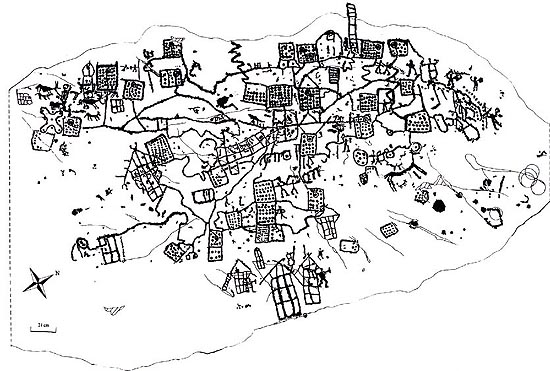Bedolina Map on:
[Wikipedia]
[Google]
[Amazon]
The Bedolina Map (formally Rock 1 of Bedolina) is a famous engraved prehistoric rock which is part of the Camonica Valley (Alps, Italian side, Lombardy region) petroglyph complex. It is known as one of the most ancient topographic maps, interpreted as a depiction of cultivated plots, mountain paths and villages. The locality of Bedolina pertains to the
Seradina-Bedolina Archaeologic park
lying on a prominent terrace on the right slope of the Camonica valley, at an altitude of 530 m above the sea level. The rock, a flat surface of Permian sandstone (Verrucano of Lombardy) polished by the Pleistocene glacier, is 9 m long and 4 m wide. A total number of 109 figures were carved during the late
A total number of 109 figures were carved during the late
EuroPreArt record
*Turconi C., 1997, ''The map of Bedolina, Valcamonica Rock Art'', TRACCE Online Rock Art Bulletin 9, online http://www.rupestre.net/tracce/?p=2422 *Arcà A. 2012, ''Topografiche: culture e colture, potere e poderi'', TRACCE Online Rock Art Bulletin 26, online http://www.rupestre.net/tracce/?p=4854 {{coord, 46, 2, 6.59, N, 10, 20, 29.72, E, region:IT-25_type:landmark_dim:20, display=title Archaeological discoveries in Italy Iron Age Rock art Alps Geology of Italy
Capo di Ponte
Capo di Ponte ( Camunian: ) is an Italian comune in Val Camonica, province of Brescia, in Lombardy.
Located above sea level, Capo di Ponte (en. "Head of Bridge") owes its name to an ancient settlement to the west of a bridge over the River Ogl ...
municipality (BS-I), near the hamlet of Pescarzo. The area is included in thSeradina-Bedolina Archaeologic park
lying on a prominent terrace on the right slope of the Camonica valley, at an altitude of 530 m above the sea level. The rock, a flat surface of Permian sandstone (Verrucano of Lombardy) polished by the Pleistocene glacier, is 9 m long and 4 m wide.
 A total number of 109 figures were carved during the late
A total number of 109 figures were carved during the late Bronze Age
The Bronze Age is a historic period, lasting approximately from 3300 BC to 1200 BC, characterized by the use of bronze, the presence of writing in some areas, and other early features of urban civilization. The Bronze Age is the second prin ...
and the Iron Age
The Iron Age is the final epoch of the three-age division of the prehistory and protohistory of humanity. It was preceded by the Stone Age ( Paleolithic, Mesolithic, Neolithic) and the Bronze Age ( Chalcolithic). The concept has been mostl ...
(1000-200 BC), mainly the so-called topographic patterns (dotted squares and zigzagging "paths"), warriors, animals, wooden huts, cup-marks and a Camunnian Rose. The rock has been completely recorded and studied by Miguel Beltrán Llorís (Beltrán Llorís 1972) and more recently by Cristina Turconi, for the Milan University.Turconi C., 2001. ''La mappa di Bedolina: il suo significato nel quadro dell'arte rupestre camuna dell'età del Ferro'', in ''Archeologia e arte rupestre. L'Europa, le Alpi, la Valcamonica. Atti del Convegno di studi, 2-5- ottobre 1997'': Milano: 239-243. According to the most recent studies and to the close examination of figures and superimpositions, the best known engraved patterns of the Bedolina Map, precisely "maps", likely pertain to the Iron Age
The Iron Age is the final epoch of the three-age division of the prehistory and protohistory of humanity. It was preceded by the Stone Age ( Paleolithic, Mesolithic, Neolithic) and the Bronze Age ( Chalcolithic). The concept has been mostl ...
, and more in detail to the central centuries of the 1st millennium BC (6th-4th centuries BC).
See also
Rock Drawings in ValcamonicaReferences
External links
*Valcamonica, Mappa di Bedolina (The Map of Bedolina)EuroPreArt record
*Turconi C., 1997, ''The map of Bedolina, Valcamonica Rock Art'', TRACCE Online Rock Art Bulletin 9, online http://www.rupestre.net/tracce/?p=2422 *Arcà A. 2012, ''Topografiche: culture e colture, potere e poderi'', TRACCE Online Rock Art Bulletin 26, online http://www.rupestre.net/tracce/?p=4854 {{coord, 46, 2, 6.59, N, 10, 20, 29.72, E, region:IT-25_type:landmark_dim:20, display=title Archaeological discoveries in Italy Iron Age Rock art Alps Geology of Italy